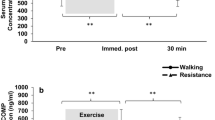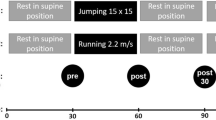Abstract
Purpose
Our aim was to investigate lubricin, cartilage oligomeric matrix protein (COMP), and femoral cartilage deformation in response to different biomechanical loading of the knee joint (running vs cycling).
Methods
Serum lubricin and COMP concentrations (enzyme-linked immunosorbent assay), and femoral cartilage thickness (suprapatellar transverse ultrasonography) were determined in 11 male runners (age: 40 ± 6 years; weight: 76 ± 8 kg) and 11 male cyclists (35 ± 12 years; 75 ± 5 kg) at baseline, immediately after, and 30 min after vigorous exercise (time trial: 10-km run or 25-km cycle).
Results
At baseline, lubricin (runners: 104.0 ± 19.8 ng/ml; cyclists: 119.1 ± 23.9 ng/ml) and COMP (runners: 804.1 ± 87.5 ng/ml; cyclists: 693.0 ± 84.7 ng/ml) did not significantly differ; however, vigorous exercise was accompanied by an increase in lubricin (cyclists: 39.4 %; p < 0.05; runners: 56.9 %; p < 0.05) and COMP (cyclists: 32.1 %; p < 0.05; runners: 14.2 %; p = 0.14) that returned toward baseline following 30 min of rest (p < 0.05). No between-group differences were observed for baseline cartilage thickness at the intercondyle notch, medial condyle, and lateral condyle, and vigorous exercise did not result in significant change for either group.
Conclusions
In the absence of ultrasonographic knee cartilage deformation, the response of serum lubricin and COMP following acute vigorous exercise indicates an increase in joint lubrication and cartilage metabolism, respectively, which appears largely independent of exercise modality.



Similar content being viewed by others
Abbreviations
- COMP:
-
Cartilage oligomeric matrix protein
- ELISA:
-
Enzyme-linked immunosorbent assay
- MRI:
-
Magnetic resonance imaging
- OA:
-
Osteoarthritis
- PRG-4:
-
Proteoglycan-4
- US:
-
Ultrasound
- VO2max :
-
Maximum oxygen uptake
References
Abraham AM, Goff I, Pearce MS, Francis RM, Fraser B (2011) Reliability and validity of ultrasound imaging of features of knee osteoarthritis in the community. BMC Musculoskelet Disord 12:70
Abusara Z, Krawetz R, Steele B et al (2013) Muscular loading of joints triggers cellular secretion of PRG4 into the joint fluid. J Biomech 46:1225–1230. doi:10.1016/j.jbiomech.2013.02.027
Akkaya S, Akkaya N, Ozcakar L et al (2013) Ultrasonographic evaluation of the femoral cartilage thickness after unilateral arthroscopic partial meniscectomy. Knee Surg Sports Traumatol Arthrosc 21:1104–1110. doi:10.1007/s00167-012-2081-8
Bauer DC, Hunter DJ, Abramson SB et al (2006) Classification of osteoarthritis biomarkers: a proposed approach. Osteoarthritis Cartilage 14:723–727. doi:10.1016/j.joca.2006.04.001
Catterall JB, Thomas V, Flannery CRS, Kraus VB (2010) Changes in serum and synovial fluid biomarkers after acute injury (NCT00332254). Arthritis Res Ther 12:R229. doi:10.1186/ar3216
Cotofana S, Ring-Dimitriou S, Hudelmaier M et al (2010) Effects of exercise intervention on knee morphology in middle-aged women: a longitudinal analysis using magnetic resonance imaging. Cells Tissues Organs 192:64–72
D’Lima DD, Steklov N, Patil S, Colwell CW (2008) The Mark Coventry award: in vivo knee forces during recreation and exercise after knee arthroplasty. Clin Orthop Relat Res 466:2605–2611. doi:10.1007/s11999-008-0345-x
Driban JB, Hootman JM, Sitler MR et al (2015) Is participation in certain sports associated with knee osteoarthritis? A systematic review. J Athl Train. doi:10.4085/1062-6050-50.2.08
Eckstein F, Lemberger B, Gratzke C et al (2005) In vivo cartilage deformation after different types of activity and its dependence on physical training status. Ann Rheum Dis 64:291–295. doi:10.1136/ard.2004.022400
Eckstein F, Ateshian G, Burgkart R et al (2006) Proposal for a nomenclature for magnetic resonance imaging based measures of articular cartilage in osteoarthritis. Osteoarthritis Cartilage 14:974–983
Elsaid KA, Zhang L, Waller K et al (2012) The impact of forced joint exercise on lubricin biosynthesis from articular cartilage following ACL transection and intra-articular lubricin’s effect in exercised joints following ACL transection. Osteoarthritis Cartilage 20:940–948. doi:10.1016/j.joca.2012.04.021
Franciozi CES, Tarini VAF, Reginato RD et al (2013) Gradual strenuous running regimen predisposes to osteoarthritis due to cartilage cell death and altered levels of glycosaminoglycans. Osteoarthritis Cartilage 21:965–972. doi:10.1016/j.joca.2013.04.007
Guilak F (2011) Biomechanical factors in osteoarthritis. Best Pract Res Clin Rheumatol 25:815–823. doi:10.1016/j.berh.2011.11.013
Halász K, Kassner A, Mörgelin M, Heinegård D (2007) COMP acts as a catalyst in collagen fibrillogenesis. J Biol Chem 282:31166–31173. doi:10.1074/jbc.M705735200
Helmark IC, Petersen MCH, Christensen HE et al (2012) Moderate loading of the human osteoarthritic knee joint leads to lowering of intraarticular cartilage oligomeric matrix protein. Rheumatol Int 32:1009–1014. doi:10.1007/s00296-010-1716-7
Hinterwimmer S, Feucht MJ, Steinbrech C et al (2013) The effect of a six-month training program followed by a marathon run on knee joint cartilage volume and thickness in marathon beginners. Knee Surg Sport Traumatol Arthrosc 22:1353–1359. doi:10.1007/s00167-013-2686-6
Ikegawa S, Sano M, Koshizuka Y, Nakamura Y (2000) Isolation, characterization and mapping of the mouse and human PRG4 (proteoglycan 4) genes. Cytogenet Cell Genet 90:291–297
Jay GD, Torres JR, Rhee DK et al (2007) Association between friction and wear in diarthrodial joints lacking lubricin. Arthritis Rheum 56:3662–3669. doi:10.1002/art.22974
Kara M, Tiftik TT, Öken Ö et al (2013) Ultrasonographic measurement of femoral cartilage thickness in patients with spinal cord injury. J Rehabil Med 45:145–148. doi:10.2340/16501977-1092
Kazam JK, Nazarian LN, Miller TT et al (2011) Sonographic evaluation of femoral trochlear cartilage in patients with knee pain. J Ultrasound Med 30:797–802
Kersting UG, Stubendorff JJ, Schmidt MC et al (2005) Changes in knee cartilage volume and serum COMP concentration after running exercise. Osteoarthritis Cartilage 13:925–934. doi:10.1016/j.joca.2005.06.005
Kessler MA, Glaser C, Tittel S et al (2006) Volume changes in the menisci and articular cartilage of runners: an in vivo investigation based on 3-D magnetic resonance imaging. Am J Sports Med 34:832–836. doi:10.1177/0363546505282622
Kutzner I, Heinlein B, Graichen F et al (2012) Loading of the knee joint during ergometer cycling: telemetric in vivo data. J Orthop Sport Phys Ther 42:1032–1038
Law R-J, Saynor ZL, Gabbitas J et al (2015) The effects of aerobic and resistance exercise on markers of large joint health in stable rheumatoid arthritis patients: a pilot study. Musculoskelet Care. doi:10.1002/msc.1103
Levick JR, McDonald JN (1995) Fluid movement across synovium in healthy joints: role of synovial fluid macromolecules. Ann Rheum Dis 54:417–423. doi:10.1136/ard.54.5.417
Mosher TJ, Liu Y, Torok CM (2010) Functional cartilage MRI T2 mapping: evaluating the effect of age and training on knee cartilage response to running. Osteoarthritis Cartilage 18:358–364. doi:10.1016/j.joca.2009.11.011
Mow VC, Guo XE (2002) Mechano-electrochemical properties of articular cartilage: their inhomogeneities and anisotropies. Annu Rev Biomed Eng 4:175–209. doi:10.1146/annurev.bioeng.4.110701.120309
Mündermann A, Dyrby CO, Andriacchi TP, King KB (2005) Serum concentration of cartilage oligomeric matrix protein (COMP) is sensitive to physiological cyclic loading in healthy adults. Osteoarthritis Cartilage 13:34–38. doi:10.1016/j.joca.2004.09.007
Naredo E, Acebes C, Moller I et al (2009) Ultrasound validity in the measurement of knee cartilage thickness. Ann Rheum Dis 68:1322–1327. doi:10.1136/ard.2008.090738
Neidhart M, Hauser N, Paulsson M et al (1997) Small fragments of cartilage oligomeric matrix protein in synovial fluid and serum as markers for cartilage degeneration. Rheumatology 36:1151–1160. doi:10.1093/rheumatology/36.11.1151
Neidhart M, Müller-Ladner U, Frey W et al (2000) Increased serum levels of non-collagenous matrix proteins (cartilage oligomeric matrix protein and melanoma inhibitory activity) in marathon runners. Osteoarthritis Cartilage 8:222–229. doi:10.1053/joca.1999.0293
Ni G-X, Lei L, Zhou Y-Z (2012) Intensity-dependent effect of treadmill running on lubricin metabolism of rat articular cartilage. Arthritis Res Ther 14:R256. doi:10.1186/ar4101
Niehoff A, Muller M, Bruggemann L et al (2011) Deformational behaviour of knee cartilage and changes in serum cartilage oligomeric matrix protein (COMP) after running and drop landing. Osteoarthritis Cartilage 19:1003–1010. doi:10.1016/j.joca.2011.04.012
Novince CM, Koh AJ, Michalski MN et al (2011) Proteoglycan 4, a novel immunomodulatory factor, regulates parathyroid hormone actions on hematopoietic cells. Am J Pathol 179:2431–2442. doi:10.1016/j.ajpath.2011.07.032
Nugent-Derfus GE, Takara T, O’Neill JK et al (2007) Continuous passive motion applied to whole joints stimulates chondrocyte biosynthesis of PRG4. Osteoarthritis Cartilage 15:566–574. doi:10.1016/j.joca.2006.10.015
O’Reilly SC, Muir KR, Doherty M (1999) Effectiveness of home exercise on pain and disability from osteoarthritis of the knee: a randomised controlled trial. Ann Rheum Dis 9:15–19
Özçakar L, Tunç H, Öken Ö et al (2014) Femoral cartilage thickness measurements in healthy individuals: learning, practicing and publishing with TURK-MUSCULUS. J Back Musculoskelet Rehabil 27:117–124. doi:10.3233/BMR-130441
Öztürk GT, Malas FÜ, Yldzgören MT et al (2015) Ultrasonographic assessment of the femoral cartilage thickness in patients with Pes Planus. Am J Phys Med Rehabil 94:568–572. doi:10.1097/PHM.0000000000000214
Piscoya JL, Fermor B, Kraus VB et al (2005) The influence of mechanical compression on the induction of osteoarthritis-related biomarkers in articular cartilage explants. Osteoarthritis Cartilage 13:1092–1099. doi:10.1016/j.joca.2005.07.003
Racunica TL, Teichtahl AJ, Wang Y et al (2007) Effect of physical activity on articular knee joint structures in community-based adults. Arthritis Rheum 57:1261–1268. doi:10.1002/art.22990
Rhee DK, Marcelino J, Baker M et al (2005) The secreted glycoprotein lubricin protects cartilage surfaces and inhibits synovial cell overgrowth. J Clin Invest 115:622–631. doi:10.1172/JCI200522263.622
Saxne T, Heinegard D, Heinegård D (1992) Cartilage oligomeric matrix protein: a novel marker of cartilage turnover detectable in synovial fluid and blood. Br J Rheumatol 31:583–591
Sharif M, Saxne T, Shepstone L et al (1995) Relationship between serum cartilage oligomeric matrix protein levels and disease progression in osteoarthritis of the knee joint. Br J Rheumatol 34:306–310
Tarhan S, Unlu Z, Goktan C (2003) Magnetic resonance imaging and ultrasonographic evaluation of the patients with knee osteoarthritis: a comparative study. Clin Rheumatol 22:181–188. doi:10.1007/s10067-002-0694-x
Urquhart DM, Tobing JFL, Hanna FS et al (2011) What is the effect of physical activity on the knee joint? A systematic review. Med Sci Sports Exerc 43:432–442. doi:10.1249/MSS.0b013e3181ef5bf8
Van Ginckel A, Baelde N, Almqvist KF et al (2010) Functional adaptation of knee cartilage in asymptomatic female novice runners compared to sedentary controls. A longitudinal analysis using delayed Gadolinium Enhanced Magnetic Resonance Imaging of Cartilage (dGEMRIC). Osteoarthritis Cartilage 18:1564–1569. doi:10.1016/j.joca.2010.10.007
Vignon É, Valat JP, Rossignol M et al (2006) Osteoarthritis of the knee and hip and activity: a systematic international review and synthesis (OASIS). Jt Bone Spine 73:442–455. doi:10.1016/j.jbspin.2006.03.001
Vilı́m V, Vobůrka Z, Vytášek R et al (2003) Monoclonal antibodies to human cartilage oligomeric matrix protein: epitope mapping and characterization of sandwich ELISA. Clin Chim Acta 328:59–69. doi:10.1016/S0009-8981(02)00375-3
Young AA, McLennan S, Smith MM et al (2006) Proteoglycan 4 downregulation in a sheep meniscectomy model of early osteoarthritis. Arthritis Res Ther 8:R41. doi:10.1186/ar1898
Acknowledgments
The authors thank all the participants who volunteered for this study.
Author information
Authors and Affiliations
Corresponding author
Ethics declarations
Conflict of interest
The authors disclose that no funding was received for this work and have no conflicts of interest to declare.
Additional information
Communicated by Olivier Seynnes.
Rights and permissions
About this article
Cite this article
Roberts, H.M., Moore, J.P., Griffith-McGeever, C.L. et al. The effect of vigorous running and cycling on serum COMP, lubricin, and femoral cartilage thickness: a pilot study. Eur J Appl Physiol 116, 1467–1477 (2016). https://doi.org/10.1007/s00421-016-3404-0
Received:
Accepted:
Published:
Issue Date:
DOI: https://doi.org/10.1007/s00421-016-3404-0




